|
| |
Back to light
transports
|
|
The Generalavia F20 is one of a large number
of Italian post-war aircraft to be designed by talented engineer
Stelio Frati. It comes in various flavours: a six seat piston
engined light transport (top picture, seen at Toussus in June 1979)
and a four seat turboprop powered trainer and general purpose
aircraft (lower picture, seen at Paris - Le Bourget in May 1983,
just 21 days after the type first flew).
The turboprop version has a top speed of 320 mph,
a range of 1,900 miles and a payload (including pilot and fuel) of
2,900lb. Its only drawback is that it's quite expensive.
|
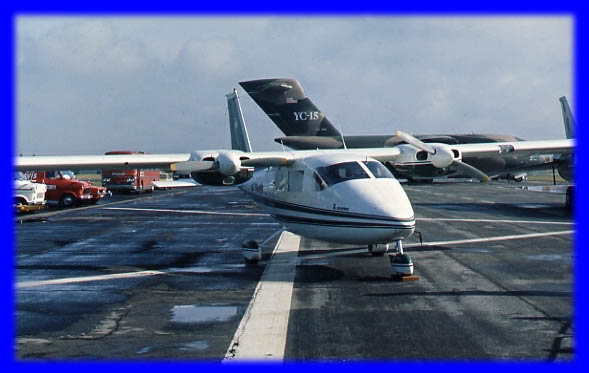
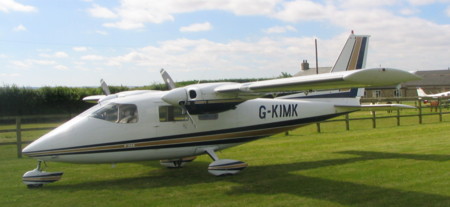 |
The Partenavia P68 Victor is a six seat light
twin built in Italy. It has a range of 1,000 miles at 180mph. It
first flew in 1964. Several hundred have been built, making it one
of the more successful Italian aircraft of recent times.
Top: Farnborough in 1976. Note also the McDonnell Douglas YC15
transport in the background: this was never produced but influenced
the design of the current C-17. Lower:
Top Farm, August 2007 |
 |
The Piaggio 136 is a flying boat produced in
Italy in the 1950s. Unusually, the two piston engines are mounted
backwards to drive pusher propellors. The inner section of the wing
is angled sharply upwards to keep the engines clear of spray when
landing or taking off on water. The prototype flew in AUgust 1948.
It is a five seater. Range is a respectable 1,0000 miles and,
despite its appearance, it manages to cruise at 170mph.
This one was seen in California in 1981. |
 |
The Piaggio 166 was a refined, land based
development of the 136. It shares the angled wing and twin pusher
engines. First flown in November 1957, it was kept in low-rate
production for many years. It seats up to eight people plus crew,
and cruises at 200mph. Its main drawback is range, being only 500
miles. This one was at Farnborough in
September 1980. |
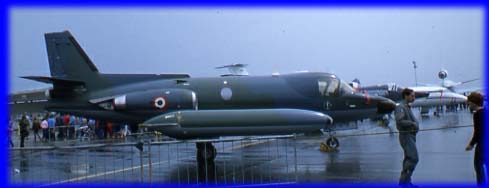 |
The Piaggio PD808 started life as a joint
venture between the Italian Piaggio company and Douglas of the USA.
A conventional twin engined business jet, looking a bit like a Lear
Jet, it was used by the Italian air force but not many other people.
It first flew in 1964, can carry 10 people, cruises at 450mph and
has a range of 1,270 miles. This one was
at a very wet Greenham Common in July 1983. |
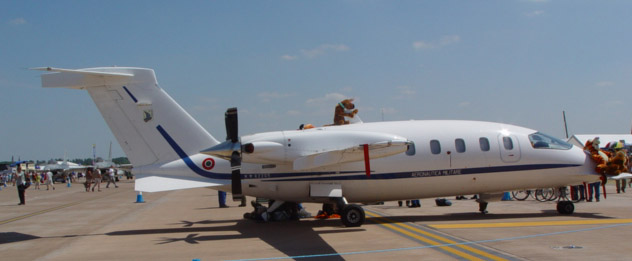 |
The Piaggio P-180 Avanti follows the
traditional Piaggio pusher configuration, but is a very advanced
design compared to the 166. It has a canard configuration plus a
tailplane, carefully placed with respect to the centre of gravity so
that all three horizontal surfaces generate positive lift, therefore
keep the wing area to a minimum and also minimise drag. It is
powered by two 850hp Pratt & Whitney Canada PT6 turboprops, which
give it a top speed of 400mph and range of 1,600 miles. It can carry
nine people plus two crew; gross weight is 11,550lb. It is 47 feet 4
inches long, with a wing span of 46 feet 1 inch. It first flew in
September 1986. As of March 2006 it is still in production, with
over 40 having been sold. This one,
operated by the Italian air force, was at Fairford in July 2005. |
|
Japan |
 |
|
The Mitsubishi Mu2 is one of a small number
of aircraft produced in recent times in Japan. It first flew in
1963. It is powered by two Garrett AiResearch turboprops. It can
carry up to 11 people at 300mph over 1,450 miles. It was widely used
until the 1980s when a small number of incidents, mainly connected
with icing, gave the type a somewhat undeserved poor safety record.
This one (a Mu2N Marquise) was at Farnborough in
September 1980. |
 |
The Mitsubishi Diamond was Japan's first
executive jet design. It first flew in August 1978. It can take up
to seven people (plus crew) at 500 mph for 1,900 miles. The design
was bought by Beech in the 1980s and re-branded as the Beechjet 400.
This one was seen at Paris - Le Bourget in May
1983. |
|
New Zealand |
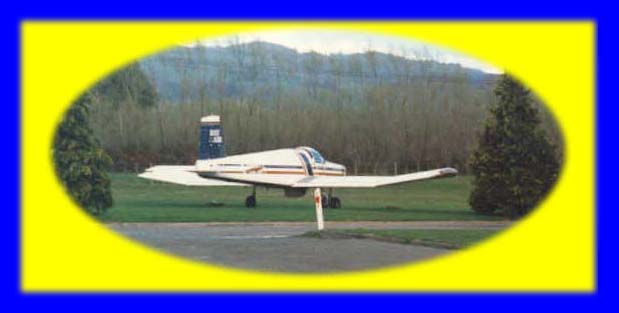 |
|
The Fletcher FU24 is one of a very small
number of aircraft from New Zealand. First flown in 1954, it
remained in low-rate production for over 40 year, with 300
ultimately having been built. Despite its ungainly appearance it is
a very capable load-carrier, with payload of 1,680lb in addition to
the pilot and fuel. It can be used as an agricultural aircraft (its
original purpose), light freighter or 5 passenger transport. Note
the cranked wing, reminiscent of the Jodel series.
This one was seen at an airstrip in Auckland, NZ,
in 1988. |
 |
The Pacific Aerospace PAC-750XL
has a long ancestry. It derives ultimately from John Thorp's
Fletcher FU24 (above), via the Cresco agricultural and utility
aircraft (which has a useful load of 7,500lb - very useful indeed).
But the PAC-750 has a new, large fuselage optimised for taking 17
skydivers. Its name derives from the 750hp Pratt & Whitney Canada
PT6 turboprop engine. The PAC-750 version was certified in March
2004 and, at the time of writing, is in the very early stages of
production. It is a large machine, 38 feet 10 inches long and with a
wing span of 42 feet. It cruises at 180mph and has a range of 670
miles.
This one is operated by Skydive Goteborg, and was
pictured (badly) at Gothenburg (Save) in September 2005. |
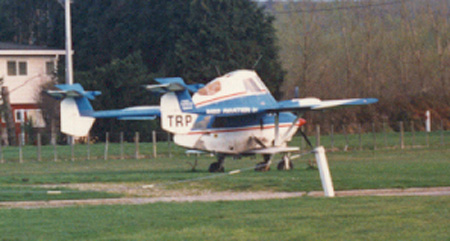 |
The Transavia Airtruk is one of
the more bizarre designs ever to have taken to the air. It is not
quite a biplane, but the little stub wings which support the
undercarriage and wing bracing struts do also provide some lift. It
is a double decker: the pilot sits, optionally with one passenger
behind him, above the main cabin, which can seat four people or hold
a hopper of chemicals. The two independent tails are designed to
allow a chemical loader to drive right up to the hopper
unobstructed. It is powered by a 300hp Continental IO-520 engine,
which gives it a gross weight of 4,090lb, cruising speed of 110mph
(all that drag keeps it slow), and range of 800 miles. It is a
stubby machine, only 20 feet 10 inches long, with a wing span of 39
feet 10 inches. It first flew in April 1965. About 120 were built.
This one was at Rotorua in 1988. |
|
Poland |
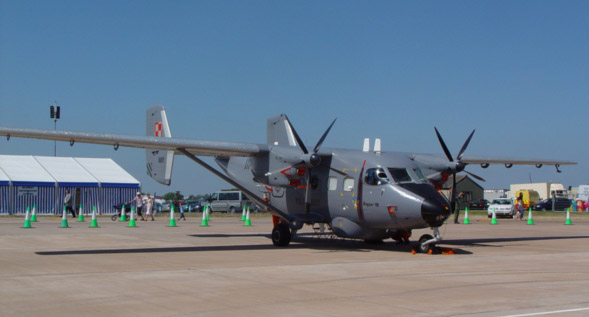 |
|
The PZL M28 Bryza (Skytruck)
started life as the Antonov An-28, production of which was
contracted to PZL in Poland. The Polish company has progressively
updated the design to produce this modern and effective tough,
utilitarian machine. It can carry 20 people plus two crew at 170mph
for 850 miles. Its two 1,100hp Pratt & Whitney Canada PT6 turboprops
give it a gross weight of 15,400lb. It is 43 feet long, with a high
aspect ratio wing spanning 72 feet 5 inches. It first flew in 1993.
At the time of writing (March 2006), it is still in production.
This Polish Air Force example was at Fairford, July 2005 |
|
Russia |
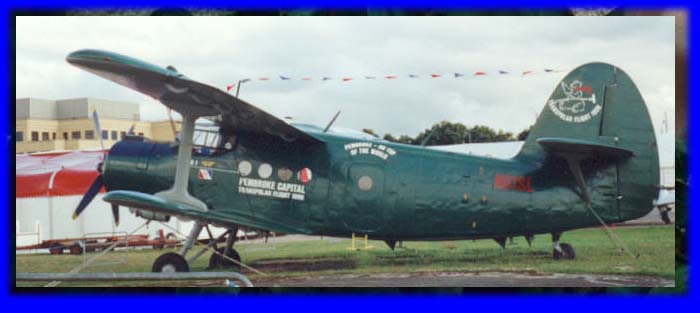
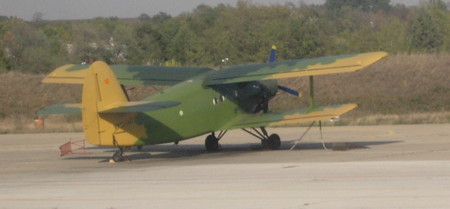 |
|
The second design from Oleg Antonov's
Ukrainian design bureau, the Antonov An2 (NATO codename Colt) is one of the most widely
built aircraft in the world, and vies with the Beech 18 and Piper
Cub for longevity in production. Its main strength is slow handling
to be able to operate into almost any airfield, however hostile. Its
massive 1,000 horsepower radial engine manages a speed of only
115mph, but carrying 1,100 lb or twelve people. It was first flown
in 1947 and was still in production into the 1980s.
Top: An2 at Farnborough in September 1998.
Lower: An2 of the Macedonian Air Force at Skopje,
October 2007 |
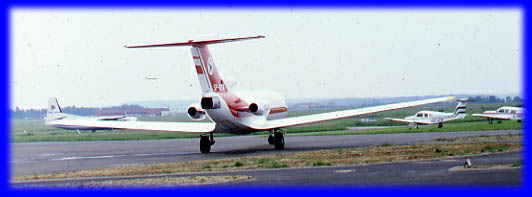 |
The Yakovlev YAK40 (NATO codename Codling) would have been a commuter
airliner, except that the Soviet Union didn't have commuters so it
was a small airliner. Its three engines were a safety feature. It
can carry up to 38 people at 340mph for 1,240 miles. It first flew
in October 1966. It was not widely used outside the former Soviet
block. This Polish example (SP-GEA) was
at Toussus in June 1979. |
|
Switzerland |
 |
|
The Pilatus PC6 Porter is a very rugged
utility aircraft built by the famous Swiss company. The original
piston-engined Porter first flew in 1959 but was superseded in the
mid 1960s by this turboprop engined version. Powered by a French
Turbomeca Astazou engine, it can carry up to 9 people or a lot of
freight at 160mph for 630 miles. A version was built under license
by Fairchild in the USA for the US armed forces as the U-23
Peacemaker. This one was at a
beautifully sunny Farnborough in September 1980. |
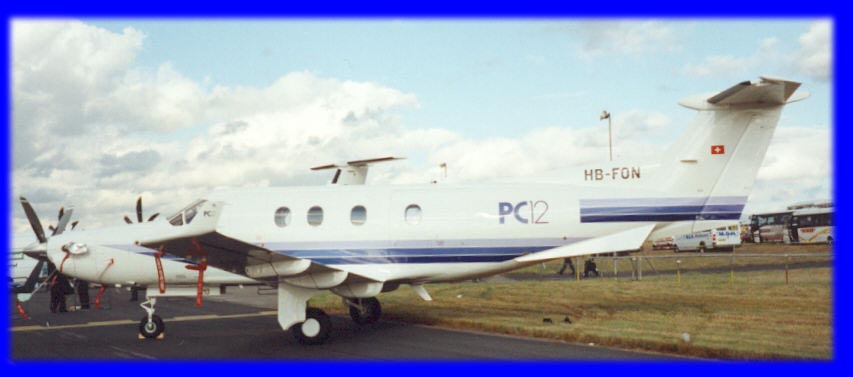 |
The Pilatus PC12 is a direct competitor to
the Cessna Caravan in the single engined turboprop utility category.
It first flew in May 1991. It can carry a load of 4,200lb (including
fuel) for 1,600 miles at 300mph. It is very popular with light
freight operators. This one was at
Farnborough in 1998. |





|